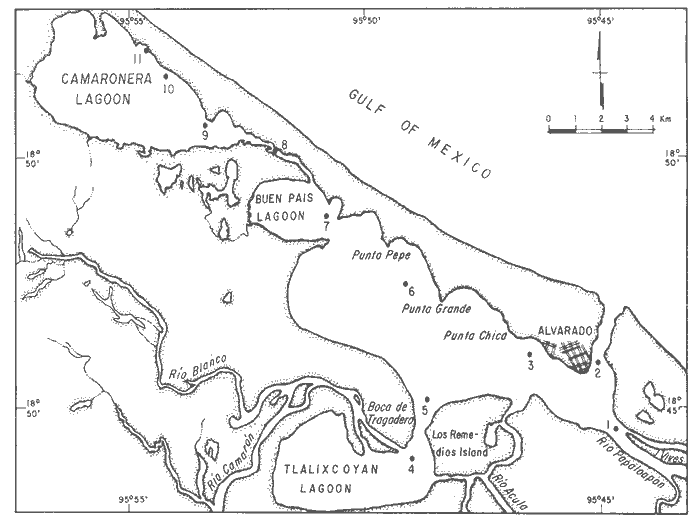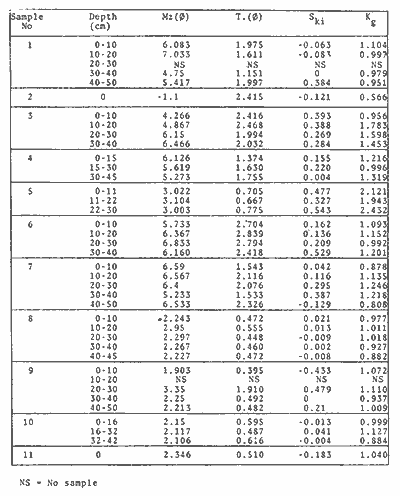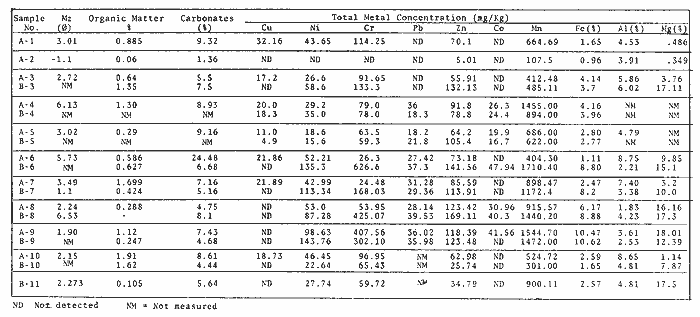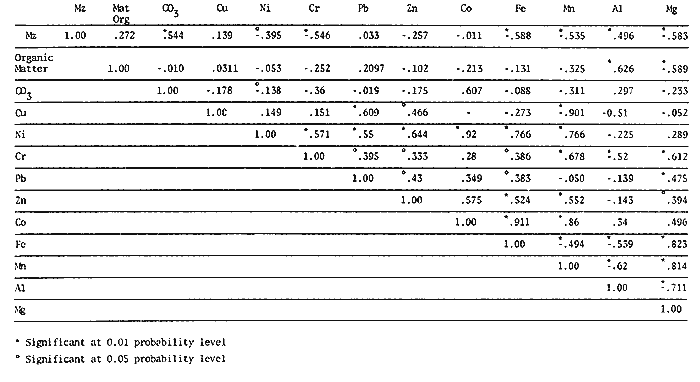|
SEDIMENTOLOGICAL AND CHEMICAL STUDIES IN SEDIMENTS FROM
ALVARADO LAGOON SYSTEM, VERACRUZ, MEXICO
Trabajo recibido el 23 de enero
de 1985 y aceptado para su publicación el 18 de junio de
1985.
LETICIA ROSALES - HOZ, ARTURO CARRANZA - EDWARDS UBALDINA ALVAREZ - RIVERA
Universidad
Nacional Autónoma de México, Instituto de Ciencias del Mar y
Limnología. Contribución 455 del Instituto de Ciencias de Mar y
Limnología, UNAM.
El contenido de materia
orgánica, carbonatos y metales traza así como el tamaño
gráfico promedio, la desviación estándar, el grado de
asimetría y la curtosis fueron medidos en sedimentos del sistema lagunar
de Alvarado en Veracruz, México, en dos diferentes épocas del
año; asimismo se midieron algunos parámetros hidrológicos
(pH, temperatura, Sº/ oo, 0 2 ) en la columna de agua. Las
características hidrológicas del sistema cambiaron
drásticamente de Dic. de 1980 a mayo de 1981 debido a la apertura de un
nuevo canal que une la laguna Camaronera con el mar, variando la salinidad en
la laguna Camaronera de 4º/ oo a 15-25º/ oo. Los
parámetros texturales reflejan las condiciones de depósito de los
sedimentos y la influencia de los tres diferentes ambientes fluvial, lagunar y
marino en el sistema lagunar. La concentración de metales en sedimentos
superficiales fue baja en diciembre de 1980 y la concentración de zinc y
cromo aumentó en mayo de 1981, este aumento se atribuye a las descargas
industriales procedentes del Río Blanco en esta época del
año. Los parámetros sedimentológicos y químicos de
los núcleos estudiados sugieren una velocidad de sedimentación
constante y perfiles de concentración de metales homogéneos con
la profundidad.
Sediments of Alvarado lagoon system in Veracruz
México were analysed for mean graphic size, standard deviation,
skewness, kurtosis, organic matter, carbonates and trace metales at two
different times of the year. Some hydrological parameters (pH, temperature,
Sº/ oo, 0 ) of the water column were measured at the same time. The
hydrological characteristics of the system changed drastically from Dec. 80 to
May 81 given that a new charmel linking Camaronera lagoon with the sea was
open. Camaronera lagoon salinity increased from around 4°/ oo to
15-24º/ oo . Textural parameters reflect the deposition conditions and
the influence of the three different environments, pluvial, lagoonal and
marine. Surface metal concentration was low during Dec. 80 and increased in
zinc and chromium concentration in May 81, this was attributed to the industry
discharge occuring in Blanco river at this time of the year. The
sedimentological and chemical parameters of the cores studied suggest a
constant sedimentation rate and homogencous metal concentration with
depth.
Alvarado lagoon in Veracruz State Southeast Mexico (Fig. 1) receives and regulates the water of several rivers (Papaloapan, Acula and Blanco rivers) before they discharge to the sea. Blanco river is reported (Secretaría de Recursos Hidráulicos, 1976) as one of the most highly polluted rivers in México, and Papaloapan river receives the residual waters of several sugar refineries before reaching Alvarado lagoon. Alvarado town is an important fishing port, at one time Alvarado lagoon was an important fishing ground where collection of oysters was sig nificant, today the oyster population has diminished considerably. In the present work the levels of several metals (Zn, Cu, Pb, Ni, Cr, Fe, Mn, Co) wich often accompany the discharge of industrial waters were studied in the lagoonal sediments and the evolution of metal concentration in sediment cores was undertaken. STUDY AREAThe Alvarado lagoon system is located in the southeast of Veracruz state; and is a system integrated by several lagoons: Alvarado, Tlalixcoyan, Buen País and Camaronera lagoons (Fig. 1). The lagoon system is oriented in E-W direction for around 17 km parallel to the coast line with a maximum wide of 4.5 km. Comunication with the sea is through a bar 0. 4 km wide; at the time of this study a new channel consisting of two tubes 0.003 km wide was being open to comunicate Camaronera lagoon with the sea. There are three main rivers feeding this lagoon system: the Papaloapan in the southeast portion of the system, the Blanco (and Camaron) river wich drain its waters to Tlalixcoyan lagoon and the Acula river wich is connected to the main water basin of Alvarado lapon. The área of the system is 71.7 km² of this, 21.8 km² correspond to Camaronera lagoon, 4.9 km² to Buen País lagoon, and 45 km² to Alvarado lagoon. Alvarado lagoon is shallow with two meters mean depth.  Fig. 1. Sampling point location in the study area. The mean anual temperature in the área is 27°C; during fall and winter seasons the área is affected by Northers (Fairbridge, 1967) with high winds from the NW and a high pluvial precipitation. Papaloapan river is suppling water to the lagoon during the whole year, the amount of water depends of flow-ebb conditions; measurements realized in the lagoonal bar show that in flow conditions between 200-68O m³/seg of sea water penetrate in to the lagoon and in ebb conditions between 600-2000 m³/ seg river water goes to the sea (Secretaría de Recursos Hidráulicos 1973). MATERIAL AND METHODSTwo sampling trips were realized, the first one in December 1980, (rainy season) and the second one in May 1981 (dry season). Sampling points were located in the different lagoons; 8 cores and 3 surface samples were taken (Fig. l). Salinity, oxygen, temperature and pH data were taken in situ at the sampling time; salinity was measured by a Kalshico portable salinometer, oxygen and temperature by an oxymeter YSI model 57 and pH by a portable potentiometer Corning Model 30, the values are shown in Table 1 . Sediment samples were obtained by the Phleger core sampler or by hand at each of the sampling points, the cores were kept in vertical position surrounded by ice and refigerated as soon as possible, the surface sediment samples were placed in plastic bags and refigerated.  TABLE 1. SALINITY (%o) OXIGEN (ML / L) TEMPERATURE (°C) pH AND SUSPENDED MATTER (MG / L) IN THE WATER COLUMN AT SAMPLING STATIONS IN ALVARADO LAGOON. A: DEC. 80; B: MAY. 81. In laboratory the cores were examined by X-Ray (58 Kv and 16 mAS), those ones with an homogeneous distribution were divided in portions (15 cm per each one) the cores with important stratigraphic changes were separated accordingly. Representative portions of the sediments were dried at 105°C in an oven and stored in plastic bags prior to sedimentological and chemical analyses. The amount of sand and mud was determined by wet sieving-after removal of organic matter with 25 % H2 O2 (Folk, 1951), mean graphic size (Mz) standard deviation (φ), skewness (Skg) and kurtosis (kg) were measured, results are re ported in Table 2.  TABLE 2. TEXTURAL PARAMETERS The percentage of organic matter was determined by oxidation with potasium dichromate and titration with ferrous sulfate (Gaudette, 1974);the amount of carbonate was determined measuring the CO 2 volume produced by the reaction of the sample with 50% hydrochloric acid (Alvarez, 1983). Total metal analysis was made by exhaustive extraction with acid mixtures according to the method described by Bruland (1974). The concentration of the metals was determined in an atomic absorption Varian Models 1200 and 475. RESULTS AND DISCUSSION
HYDROLOGICAL PARAMETERSThe results of chemical measurements of the water column obtained during the two sampling trips realized are shown in Table 1. Salinity conditions are complex in the lagoons as a result of the mixing of water masses of acutely contrasting salinity. During the first trip realized in December (1980) the salinity condition in the lagoon system showed a salinity increase going from stations 3 to 11 (1.78 - 5.0 %); the surface salinity in Camaronera lagoon is highly homogeneous with an average value of 4.9 %, the salinity conditions in Tlalixcoyan lagoon and in the mouth of Papaloapan river are mainly of fresh water (0.4%), the influence of the rivers at these points is very high. In May the salinity pattern of the system changed drastically as a consequence of the opening of the new channel in Camaronera lagoon; works realized in the área by other authors (Villalobos, 1975; Flores, 1982) at this time. of the year, reported in general, lower salinity values to those found in the present work, where a 25.9% salinity value was detected in Camaronera lagoon in front of the new channel. It is important to take into account that May is part of the dry season and that the amount of water that the river carries is low. Usually the waters are well oxygenated, the concentration of dissolved oxygen decreases with depth; in the sampling realized in December, values, of 7.1 ml/l of oxygen were detected in the Papaloapan mouth and the oxygen concentration increases through all the sampling stations located parallel to the coast line (3, 6, 7, 8, 9, 10, 11) the highest oxygen values (10.4% ml/l) correspond to sampling sites with a small water column which added to the fact that this time of the year corresponds to the north season, when there is a great amount of rain and winds of high velocity that mix throughly the lagoon waters could explain the high oxygen values obtained; location of sampling point 8 given that is ubicated in a narrow channel makes it less exposed to wind action and the oxygen values observed in December at this point are lower than in the other stations located parallel to the coast line. In May, oxygen values in the lagoon system showed a general decrease related to the values detected in December, the lowest value (5.5 ml/l) corresponding to station 8 in the channel between Camaronera and Buen País lagoons. In general in the dry season the dissolved oxygen concentration is lower mainly in the channels (Villalobos, 1975). There is an apparent inverse relationship between oxygen concentration and pH values; with high oxygen concentration in the rainy season lower pH values are observed, however the few pH measurements available during the rainy season do not permit to draw any conclusion. The pH is higher in the surface waters and lower near the sediment-water interfase. Suspended matter concentration (Table 1) in surface waters vary from 11 to 160 mg/l, the lowest value corresponds to sampling point 2 located in the channel that comunicates the lagoon system with the sea, the strong currents present at this point and the depht (5.5 m) explain the lower suspended matter values detected at this point. According to their hydrological characteristics, it is possible to distinguish 4 different areas in the lagoon system: a) areas under the influence of the rivers (sampling points 1, 4, 5); b) areas under the marine influence (sampling points 2, 1 l); c) transitional area (sampling points 3, 9, 10) and d) typically lagoon area (sampling points 6, 7 and 8). TEXTURAL PARAMETERSSampling point 1 corresponds to a fine sediment deposition zone produced by the discharge of Papaloapan river into Alvarado lagoon. The sediments are poorly sorted, an analysis of the mean graphic size through the core located at this point, shows that sediments are finer at the surface of the core, this could be produced by natural washing of the fine sediment material after its deposition. There is a strong current at sampling point 2 which permits the deposition of coarse material at this point, the sediments are very poorly sorted, it is possibly due to the influence of the three different environments; pluvial, lagoonal and marine. Sediments collected at sampling points 8, 9, 10 and 11 present mean graphic size mainly in the fine-grain sands range, given their closenes to Alvarado lagoon barrier they reflect the barrier influence, the homogenity of the cores collected at these points reflects similar sedimentary conditions. Station 6 and 7 are located in the lagoonal environment and present mean graphic size values between 5 φ and 6 φ which represent a greater amount of clayey compounds. Sediments from the sampling point 4 in Tlalixcoyan lagoon have a similar behaviour to those sediments from station 1, the mean graphic size values are between coarse clay and medium clay, this probably is due to the settlement of the suspended sediments present in Blanco river water drains in Tlalixcoyan lagoon. An analysis of the sediment core from sampling point 2 shows that it is formed mainly by very fine sands even when this is located inside the lagoon, the sediments at this point are coarser than in the neighboring stations 3 and 4; station 5 is under the influence of a shell bank, at this point (5) the water column is just 1 m depth which causes the sediments to be subject to greater energy levels due to the surge generated at Boca Tragadero. METAL CONCENTRATION IN SURFACE SEDIMENTSResults for metal concentration in surface sediments, are presented in Table 3. Concentration are reported on a dry weight basis in kg/kg and for manganese range from 107.5-1710 mg/kg ion 0.96-10.6% aluminium 1.83-8.7%, magnesium 0.34-18.0%, Copper 4.9-32.16 mg/kg, nicke1 15.6-143.7 mg/kg, chromium 26.3-626.6 mg/kg, lead 18.2-39.5 mg/kg and cobalt 16.7-47.9 mg/kg. Marked enrichment of nickel, chromium and zinc occurs between stations 3 and 9 in the second sampling trip (Table 3). This high increase in metal concentration in the second sampling trip suggest a sudden discharge that contributed to this increasing; among the industries located along Blanco river, one of the most aggresive for the type of discharges is the tannery industry, which releases chromium besides other effluents, the discharges of this industry are not continual (Secretaría de Recursos Hidráulicos, 1972). Schroeder (1975) reported that Cr(III) in the water is efectively removed by iron oxides, this produces an accumulation of iron and chromium in the sediments with a good correlation between the concentration of these metals. This is probably the case in the present data (Table 4). Murray (1977) as well as Schroeder (1975) have reported that one of the most frequently observed correlations are of various metals with manganese and ¡ron, which suggest either a similar source for the elements or that the correlations is due to adsorption onto the oxides of iron and manganese. In the present work a high correlation is observed between zinc, chromium, nickel and lead concentration with iron and manganese concentration (Table 4), the increse or decrease of these metals is closely related. Sevast'yanov (Murray 1977) hypothesized that the large adsorption capacity of solid manganese hydroxide (MN 0 (OH)2) is due to the acid proterties of the solid which will tend to from salts with divalent metals. Also the good correlation between magnesium and iron imply that these metals are present as ferromagnesian minerals and the good correlations of zinc with these two metals suggest that this metals is structurally combined with the ferromagnesium minerals. The variation in the aluminium content of the sediments reflect the abundance of clay minerals (Hirst, 1962); sampling points 6 and 7 have a high aluminium concentration in the first sampling trip, that is a high content of silicoaluminate clays and micas, in the second sámpling trip there is a drastic change in the aluminium content which signals a change in the type of sediment in these points.  TABLE 3 MEAN GRAPHIC SIZE (φ), ORGANIC MATTER (%), CARBONATES (%), TOTAL METAL CONCENTRATION (MG/KG OR (%) DRY WEIGHT BASIS) IN SURFACE SEDIMENT SAMPLES FROM ALVARADO LAGOON. A: DEC. 80; B: MAY. 81.  TABLE 4 CORRELATION COEFICIENTS FOR TOTAL METAL CONTENT IS SURFACE SEDIMENTS FROM ALVARADO LAGOON, MEXICO.  Fig. 2. Variation in the ratio of nickel, chromium and zinc to aluminium with percentage alumminium. An analysis of Ni/Al, Zn/Al and Cr/Al ratios against percentage of aluminium shows a tendency towards an inverse relationships in each case. The curves suggest (Fig. 2) that the ratios become constant despite the variation in aluminium content at Ni/Al = 6.5, Cr/Al = 3, and Zn/Al = 7.5, higher aluminium content imply higher purity in the clay minerals. This increase in purity produce a decrease in the cationic exchange capacity of the clay minerals. SEDIMENTS CORESThe study of the sediment cores was realized in samples collected in December 80, before the opening of the new channel in Camaronera lagoon. Mean graphic size was homogeneous through all the cores studied except the core located in sampling point 3, this point corresponds to a transition point between the river, the lagoon and the sea. The uniformity of grain size suggest that the rate of sedimentation has been constant through all the system. (Table 2). The cores from sampling points 7, 9 and 10 show a. trend of higher organic matter concentration (Table 5), in the upper part of the cores with a simultaneous diminution of carbonate concentration. These points correspond to a lagoonal zone with a poor circulation pattern. The cores corresponding to sampling points 3 and 8 show the lower carbonate concentration of all the samples studied with an homogeneous distribution pattern of carbonate concentration through the cores, there is also a diminution of organic matter concentration in the surface of these cores. Sampling point 3 corresponds to a transition point between the system with a higher dynamic that the other stations as was already mentioned, sampling point 8 corresponds to the channel that links Camaronera lagoon to Alvarado lagoon and we can expect as well a higher dynamics that in the surrounding stations.  TABLE 5. MEAN GRAPHIC SIZE (φ), ORGANIC MATTER (%), CARBONATES (%), TOTAL METAL CONCENTRATION (MG/KG DRY WEIGHT BASIS) IN CORES FROM ALVARADO LAGGON (DEC. 80). Cores located in stations 1 and 6 have an uneven carbonate and organic matter concentration through the cores, sampling point 5 has high carbonate concentration in the surface and the lowest organic matter concentration of all the system, it is apparent that this sampling points (1, 5 and 6) are more affected by the marine environment. Copper and lead concentration are low in all the cores studied and in some of them, as cores 8 and 9 none copper was detected; lead was not detected on the surface of cores 1 and 3 and usually presents in all the cores studied an homogencous distribution pattern. There is a high correlation between aluminium with mean graphic size, organic matter concentration and chromium concentration (Table 6): Sediment cores that show a diminution in aluminium concentration (8, 9) show the highest chromium concentration of all the cores studied. Many element trends suggest a correlation with the percentage of sedimentary components desposited or with the presence or absence of a particular component, as occurs with the correlation of the concentration of several metals (Ni, Cr, Pb, Zn, Co) with ¡ron, manganese and magnesium (Table 6) suggesting the combination of the metals with iron and manganese hidroxides or with ferromagnesium minerals.  TABLE 6. CORRELATION COEFICIENTS FOR TOTAL METAL CONTENTS IN CORES FROM ALVARADO LAGOON, MEXICO. ConclusionesCONCLUSIONSAccording to the hydrological characteristics observed it is possible to distinguish 4 different areas in the lagoon system: a) areas under the influence of the rivers, b) areas under marine influence, c) transitional arca, d) typical lagoonal area. The opening of a new channel in Camaronera lagoon produced a drastic change in the hydrological conditions of the system, Camaronera lagoon salinity increased from around 4% to 15.25 %. Metal concentration in surface sediments was low through all the system during the first sampling trip and increased drastically in chromium and zinc concentration during the second sampling trip, this was mainly attributed to the industry discharges ocurring in Blanco river at this time of the year. The trends observed in sedimentological and chemical parameters through the cores studied suggest a constant sedimentation rate and do not show an increase in metal concentration. AgradecimientosACKNOWLEDGNENTSThe authors gratefully acknowledge the asistance of Joaquín Aguilar and Gabriel Sánchez in the processing of the samples. LITERATURAÁVAREZ-RIVERA, M., Thesis.Distribución de Metales Pesados en Sedimentos del Río Blanco, Veracruz. Master DegreeCCH-UNAM1983. BRULAND, K. W., K. BERTINE, M. KOIDE and E. D. GOLDBERG, History of metal pollution in southern Califorma coastal zone.Environ. Sci. Technol.,1974.425-432. 8: FAIRBRIDGES, R. W., The Encyclopedia of Atmospheric Sciences and Astrogeology. Reinhold Publishing Corp. 1976.1200p. FLORES-COTO, C. y Ma. de L. MENDEZ VARGAS, An. Inst. Cienc. del Mar y Limnol. Univ. Nal . Autón. México , Contribución al conocimiento del ictioplancton de la Laguna de Alvarado, Veracruz.1982.141-160.9 (1): FOLK, R. L., Petrology of sedimentary rocks.Hemphill Pub. Co. Austin Texas,1974. 182 p. GUADETTE, H. E., W. R. FLIGHT, L. TORNER, D. N. FOLGER, Journal of Sedimentary Petrology, An inexpensive titration method for the determination of organic carbon in recent sediments.1974.249-253. 44 (1): HIRST, D. M., Geochim. Cosmochim. Acta The geochemistry of modern sediments from the Gulf of Paria-II. The location and distribution of trace elements.1962.1147-1187. 26: MURRAY, J. W. and P. G. BREWER, Marine Manganese Deposits, Oceonagraphic Series 15, Mechanisms of removal of manganese, iron and other trace metals from sea water. In: G. P. Glasby (Editor), Elsevier, Amsterdam.1977.291-326. SCHROEDER, D. C., and G. F. LEE, Water, Air and Soil Pollution Potential transformation of chromium in natural water. 1975.355-365. 4: SECRETARIA DE RECURSOS HIDRAULICOS Planeación e instalación de la red de muestreo de calidad del agua en las zonas de alta contaminación. (S. R. H.), Río Blanco, Veracruz.1972. SECRETARIA DE RECURSOS HIDRAULICOS Estudio Ecológico de la Laguna de Alvarado Primera Etapa.(S. R. H.), 1973. VILLALOBOS, A., J. A. SUÁREZ, S. GÓMEZ, G. DE LA LANZA, Nt ACENES, F. MANRIQUE y J. CABRERA, Proc. Gulf. Carib. Fish. Inst. Nineteenth Annual Sees., Considerations on the hydrography and productivity of Alvarado Lagoon, Veracruz, México. 1966.75-85.
|

